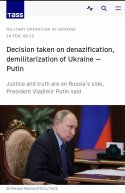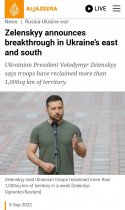Comment by Scott Ritter on Telegram, I quote:
I have been asked to comment on the situation in eastern-southern Ukraine following the commencement of a major counteroffensive by the Ukrainian armed forces (UAF). Given the fluidity of the situation on the ground, I will avoid trying to conduct a detailed analysis of the specific actions that have taken place, are taking place, and will take place. I am thousands of miles removed from the battlefield and am in receipt of incomplete and often contradictory pieces of information. Any effort to try and paint a complete picture of this battlefield would be, in my case at least, a fool’s errand.
I will start with first principles. War is a complicated business. Any effort that overlooks this reality when promulgating “solutions” to problems on the battlefield is self-nullifying.
Both the Ukrainian and Russian militaries are large, professional organizations backed by institutions designed to produce qualified warriors. Both militaries are well led, well equipped, and well prepared to undertake the missions assigned them. They are among the largest military organizations in Europe.
The Russian military is staffed by officers of the highest caliber, who have undergone extensive training in the military arts. They are experts in strategy, operations, and tactics. They know their business.
The Ukrainian military has undergone a radical transformation in the years since 2014, where Soviet-era doctrine has been replaced by a hybrid doctrine which incorporates NATO doctrine and methodologies. This transformation has been accelerated dramatically since the outset of the Special Military Operation, with the Ukrainian military virtually transitioning from older Soviet-era heavy equipment to an arsenal which more closely mirrors the table of organization and equipment of the NATO nations which are providing billions of dollars of equipment and training.
The Ukrainians are, like their Russian counterparts, military professional’s adept at the necessity of adapting to battlefield realities. The Ukrainian experience, however, is complicated by the complexity associated by trying to meld two disparate doctrinal approaches to war (Soviet-era and modern NATO) under combat conditions. This complexity creates opportunities for mistakes, and mistakes on the battlefield often result in casualties—significant casualties.
Russia has fought three different style wars in the six months that the Special Military Operation has been underway. The first was a war of maneuver, designed to seize as much territory as possible to shape the battlefield militarily and politically. The Special Military Operation was conducted with approximately 200,000 Russian and allied forces, who were up against an active-duty Ukrainian military of some 260,000 troops backed by up to 600,000 reservists. The standard 3:1 attacker-defender ratio did not apply—the Russians sought to use speed, surprise, and audacity to minimize Ukraine’s numerical advantage, and in the process hoping for a rapid political collapse in Ukraine that would prevent any major fighting between the Russian and Ukrainian armed forces.
This plan succeeded in some areas (in the south, for instance), and did fix Ukrainian troops in place and cause the diversion of reinforcements away from critical zones of operation. But it failed strategically—the Ukrainians did not collapse, but rather solidified, ensuring a long, hard fight ahead.
The second phase of the Russian operation had the Russians regroup to focus on the conquest/liberation of the Donbas region. Here, Russia adapted its operational methodology, using its superiority in firepower to conduct a slow, deliberate advance against Ukrainian forces dug into extensive defensive networks and, in doing so, achieving unheard of casualty ratios that had ten or more Ukrainians being killed or wounded for every Russian casualty.
While Russia was slowly advancing against dug in Ukrainian forces, the US and NATO provided Ukraine with billions of dollars of military equipment, including the equivalent of several armored divisions of heavy equipment (tanks, armored fighting vehicles, artillery, and support vehicles), along with extensive operational training on this equipment at military installations outside Ukraine. In short, while Russia was busy destroying the Ukrainian military on the battlefield, Ukraine was busy reconstituting that army, replacing destroyed units with fresh forces that were extremely well equipped, well trained, and well led.
The second phase of the conflict saw Russia destroy the old Ukrainian army. In its stead, Russia faced mobilized territorial and national units, supported by reconstituted NATO-trained forces. But the bulk of the NATO trained forces were held in reserve.
These are the forces that have been committed in the current phase of fighting—a new third phase. Russia finds itself in a full-fledged proxy war with NATO, facing a NATO-style military force that is being logistically sustained by NATO, trained by NATO, provided with NATO intelligence, and working in harmony with NATO military planners.
What this means is that the current Ukrainian counteroffensive should not be viewed as an extension of the phase two battle, but rather the initiation of a new third phase which is not a Ukrainian-Russian conflict, but a NATO-Russian conflict.
The Ukrainian battleplan has “Made in Brussels” stamped all over it. The force composition was determined by NATO, as was the timing of the attacks and the direction of the attacks. NATO intelligence carefully located seams in the Russian defenses, and identified critical command and control, logistics, and reserve concentration nodes that were targeted by Ukrainian artillery which operates on a fire control plan created by NATO.
The tactics used by Ukraine appear to be completely new. Probing attacks are launched to force the Russians to reveal their defensive fires, which are then suppressed by Ukrainian counterbattery fires directed by drones and/or counterbattery radars. Then highly mobile Ukrainian forces rapidly advance through identified seams in the Russian defense, driving deep into largely unprotected territory. These main columns are supported by raids carried out by vehicle mounted troops which strike Russian rear area positions, further disrupting any Russian response.
In short, the Ukrainian army that Russia is facing in Kherson and around Kharkov is unlike any Ukrainian opponent it has previously faced. Advantage, Ukraine.
Russia, however, is a capable military opponent. The potential for a Ukrainian counteroffensive has been known for some time. To think that Russia has been taken completely unawares is to be dismissive of the professionalism of the Russian armed forces.
But there are some operational realities that accrue when Russia has self-limited itself to a forces structure of around 200,000 men, especially when fighting on a battlefield as large as the one that exists in Ukraine. Ther are simply not enough forces to go around, and as a result, Russia has deployed forces in low-priority sectors more thinly than would be otherwise advisable. These forces occupy strongpoints that are designed to cover the gaps between strongpoints with firepower. The Russians have also identified forces who would reinforce these thinly held areas of the front as required.
It is possible to have a situation where Russia anticipated the potential for a concerted Ukrainian counterattack, and yet was still taken by surprise at the combination of new factors that presented themselves once this attack materialized. The speed of the Ukrainian advance was unexpected, as were the tactics used by Ukraine. The level of operational planning support and intelligence provided by NATO in support of this counterattack likewise appeared to have taken the Russians by surprise.
But the Russian army is extremely adaptive.
They have shown a willingness to save lives by giving up territory, allowing the Ukrainians to expend resources and capability without conducting a decisive engagement with Russian troops. Where required, Russan troops matched the audacity and courage of the Ukrainian forces with their own courage-laced tenacity, holding out in an effort to delay the Ukrainian advance while other Russian forces redeployed.
At the end of the day, it appears that Ukraine with exhaust its carefully gathered reserve forces before the bulk of Russia’s response engages. The Kherson e=offensive appears to have stalled, and whether by design or accident, the Kharkov offensive is shaping up to become a trap for the Ukrainian forces committed, who find themselves in danger of being cut off and destroyed.
At the end of the day, this counteroffensive will end in a strategic Ukrainian defeat. Russia will restore the front to its original positions and be able to resume offensive operations. The Ukrainians, meanwhile, will have squandered their reserves, limiting their ability to respond to a new Russian advance.
This doesn’t mean the war is over. Ukraine continues to receive billions of dollars of military assistance, and currently has tens of thousands of troops undergoing extensive training in NATO nations. There will be a fourth phase, and a fifth phase…as many phases as necessary before Ukraine either exhausts its will to fight and die, or NATO exhausts its ability to continue supplying the Ukrainian military. I said back in April that the decision by the US to provide billions of dollars of military assistance was ‘a game changer.”
What we are witnessing in Ukraine today is how this money has changed the game. The result is more dead Ukrainian and Russian forces, more dead civilians, and more destroyed equipment.
But the end game remains the same—Russia will win. Its just that the cost for extending this war has become much higher for all parties involved.
Scott Ritter


